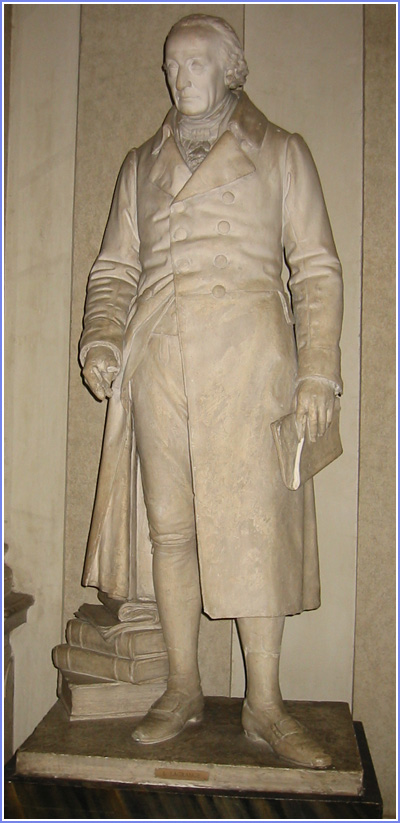Notes
for scholars :
In examining the 2nd and subsequent posthumous editions of the Mécanique analytique several
qualities are immediately
striking.
- Volume I closes with a detailed record of Lagrange's
publications. Thus, scholars have a roadmap of his contributions.
Lagrange, as a member of highly selective academies, had his complete
life's work carefully annotated and preserved.
- His introduction was in the style one often finds in 18th
century mathematics publications. He begins by listing a "few" of
those whose work he will apply. In Lagrange's case, the list of
mathematicians is staggering: Archimedes, Galileo, Stevin, Huygens,
Mersenne, Roberval, Descartes, Torricelli, Wallis, Nicomedes, Daniel
Bernoulli, Jean Bernoulli, Aristotle . . . .
- When Lagrange brought himself to write of his
personal contributions, and ceased to elaborate on the accomplishments
of others, he wrote in a style that was brief, clear and well
organized. The "Mécanique
analytique" must have been a very useful book for his contemporaries.
Today's reader finds an almost
handbook or
College Outline Series quality to the writing.
- There are absolutely no illustrations, diagrams or
pictures, only equations and formulas with text. With Euler,
Lagrange
is considered a
pioneer in the analysis of abstract non-geometrical mathematics.
However, early in his career he investigated the tautochrone (1770).
- With such an extensive list of publications, it is
difficult to select those with the most lasting impact. We shall
attempt to highlight a few. He ............
- Proved Bachet's Conjecture that every integer is the sum
of four squares.
- Developed a method for continued fractions.
- Developed several techniques and texts for solving
algebraic equations.
- Developed the
coordinates and multipliers named for him.
- Focused on the remainder in a Taylor series.
- Formulated theories for power series.
- Joined with Euler in founding Analysis.
- Joined with Euler in founding the Calculus of Variations.
- Explained and widened the standardization of calculus
notation. Lagrange
often explained
his notation, showed its application and thereby educated his readers.
After almost a century since Newton had published the Principia, calculus was still not
understood and widely used among mathematicians.
- Collaborated to establish the metric system in France.
References
and Credits
*H. Goldstein, C. Poole and
J.Safko, Classical Mechanics,
3rd ed., Addison Wesley, 2002, p. 21.
E. T. Bell, Men of Mathematics,
Simon and
Schuster, 1937.
J. L. Lagrange, Analytical mechanics,
translated and edited by Auguste Boissonnade and J. L. Vagliente,
Kluwer Academic Publishers, 1997.
J. L. Lagrange, Mécanique
analytique, Paris, Mme. Ve Courcier, 1811, pp. 383-391.
J. L. Lagrange, Méchanique
analytique, sic,
Paris, Chez la Veuve Desaint, 1788.
The Huntington Library, San Marino, CA has several editions and
translations of Lagrange's publications. We choose to cite only
the second edition, volume 1, with an extensive "Liste des Ouvrages de
Lagrange" as well as the errata to the first edition (1788). This
particular volume is signed by Poisson, Legendre, Maurice de Prony and
Lacroix (rapporteur) indicating support of the Académie Royale
des Sciences.
George Sarton, "Lagrange's Personality (1736-1813)", Proceedings of the American Philosophical
Society, Vol. 88, No.6, 1944, pp. 457-496.
The National Curve Bank thanks the Huntington Library for access to
their materials.
The National Curve Bank especially thanks James T. Smith, Professor
Emeritus of Mathematics, San Francisco State University, for the
motivation to compose this web page. As a "mathematical tourist"
he enjoyed taking the photos on a trip to Italy in 2008.
|

A large statue of Lagrange stands in the premises of the
Accademia delle Scienze di Torino of which he was a founder.
The Accademia is now on the upper floor of the Egyptian
Museum. The Lagrange translation by Boissonnade and Vagliente has
a
picture showing this statue was once located at the center of a busy
Turin
intersection.
|
 Curve
Bank Home
Curve
Bank Home

